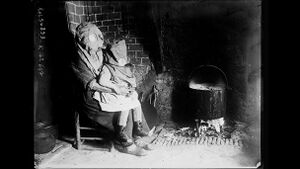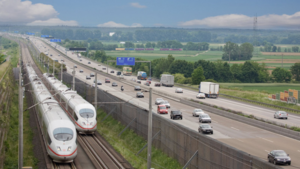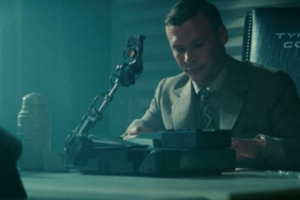The Reconstruction Era (Ostland)
The Reconstruction Era (Ostlandic: Der Wiederaufbau) is an ongoing process of rebuilding the Kingdom of Ostland after the destruction endured during the Florian invasion. Ostland suffered greatly during the invasion, in lives, infrastructure and industry. The use of chemical weapons by Florian forces further exacerbated the situation, causing severe environmental damages in many parts of the country.
Withdrawal of Forces

Following the withdrawal of forces from Ostland, the nobility was able to regroup but only to find that the Royal Family had been largely decimated. While there are a few members of the family abroad, it was decided that it was unsafe for them to return and take the throne. As such, in 1720 the Elder Nobility of Ostland convened the Reichstinge and named the closest living relative of King Nikolaus VI - Generalfeldmarschal Otto Eisenmann - as Lord Protector of the Reich of Ostland. The Lord Protector was granted all royal powers, serving as a reagent of the King until a time when it has been declared safe for the Royal Family to return.
Initial Efforts
With Ostland's lands and infrastructure ravaged by the conflict, one of the first efforts to begin reconstruction started with the creation of two new specialized, temporary ministries in the Royal Government, the Special Ministry of National Reconstruction and the Special Ministry of the Populace. Von Eisenmann immediately reorganized several departments from other existing ministries, the Arbeitskorps and some remaining military units to fall under one of the two new ministries.
Special Ministry of National Reconstruction
The ministry was created from several offices of the Ministries of the Interior, Defense, Commerce and Energy & Mining to begin immediate efforts on restoring the basic infrastructure of the country to serve its people. Several specialized units from the Ministry of Defense were immediately reorganized into the new ministry to begin emergency clean-up efforts of areas affected by the use of chemical warfare by the Florians. Arbeitskorps construction and emergency services units were also immediately deployed to areas determined to be free of any CRBN agents.
Special Ministry of the Populace
This ministry was created almost totally independent of other ministries with very little reorganization from the others. Its primary function is to establish programs for the welfare of the people following the conflict. Social and work programs, medical aid and even some special security functions were started by the ministry. One of the largest programs, The Chemical Warfare Victims Aid Society - has provided large amounts of immediate social and medical aid to victims of the gas attacks by Florian forces. This also includes long term programs for families with children of whom have been born with birth defects due to the use of blood agents as an estimated 120,000 Ostlanders were exposed to the agents - as much as 10% of that figure has been estimated to be pregnant mothers.
Ongoing Efforts
Through the two new ministries and the existing ones, the Lord Protector has initiated several on-going plans to be followed in successive stages to rebuild the infrastructure, industry and the lives of the people of Ostland.
| Plan | Description | Ministry in Charge |
|---|---|---|
| 1720 Plan for Housing Reestablishment | This plan was created in order to combat the immediate need for housing of Ostlanders | Special Ministry of National Reconstruction, Ministry of the Interior |
| 1720 Plan for Environmental Reclaimation | This plan is a multi-ministry program for all emergency and long-term environmental impact mitigation efforts resulting from the use of poison gas | Special Ministry of National Reconstruction, Ministry of Defense |
| 1720 Plan for Emergency Infrastructure | This plan was created to help with the rebuilding of the crucial infrastructure of the nation including roads, highways, electrical grids and railways | All available ministries |

In 1722, with the help of the Arbeitskorps, the original Royal Route 1 (Königslicheweg-1) expressway between Reichsborg and Großehafen with the addition of a new commuter railway track. While still retaining its K-1 designation, it has been officially named The Giftunheile Memorial Super Expressway (Die Giftunheiledenkmal Großeschnellstrasse).
Economic Policies
It was the wish of both von Eisenmann and the Reichstinge to maintain the gold standard of the Ostlandic currency - the Mark. With some gold mines still operating or very close to becoming operational as of X 1720 AN, the use of a fiat currency was debated but ultimately decided against as the risk of hyperinflation was too great to ensure a stable future for the economy.
With most of the industry and infrastructure having been severely damaged or outright destroyed by the conflict, a radical shift was required to jump-start the economy of the nation. In XI 1720 AN, Lord Protector von Eisenmann reached out to the USSRC to begin importation of aide materials to alleviate the immediate costs to an already severely damaged Ostlandic economy and industry. First Secretary Zevyagin responded with the pledge of immediate food and building materials aid, totally 1.3 billion Marks, to be sent to Ostland to alleviate the critical shortages of both until they can be domestically produced reliably.
In XII 1720 AN, Ehra was relaxed for many hard-hit provinces, while for some it was suspended in order for those provinces to keep what little funds they had.
Wir Send Alle Ostländer! Movement

The Wir Sind Alle Ostländer! (English: We are all Ostlanders!) Movement arose from the fact that the demographics of Ostland included appreciable percentages of ethnic groups coming from Giftunheile aggressor nations. However, they all suffered the same as - if not worse than in some cases - ethnic Ostlanders during the conflicts. Gas attacks and shelling wiped out the entire Elw quarter of Reichsborg, killing nearly 10,000 ethnic Elw. There were also reports of military actions against various ethnic groups during the conflict by the invading forces, especially amongst ethnic Babki and Zeedic Rus' populations. This mutual suffering brought about what has become Wir Send Alle Ostländer! creating a solidarity among the populace during the troubled times of the Reconstruction.
International Relations
Before the conflict Ostland had maintained strict neutrality, merely acting as an observer of many of the treaty organizations on Micras. This tradition would come to an end on XII 1720 AN when Lord Protector Eisenmann officially assented to the joining the MTO by ratifying the General Membership Treaty.
The Giftunheile has left us with very few options, I am afraid. Cities have been demolished, farmland burned or poisoned and our youth maimed. In the many, many centuries of our people we have maintained that we will only observe the outside world - until the outside world came to use with the great calamity. We common Norse folk have paid a very dear price for the machinations of an external force which infiltrated our pure nation. As such, I must break with our great tradition of strict neutrality. As sad as I am to say it, we will not be able to recover without some manner of help from those of whom will offer it.Make no mistake! I am not subjugating our fine nation - or our fine people - to external forces. A fear that we all have always shared. But times have changed, unfortunately, and we must adapt to survive. As such, I have officially signed the treaty documents to join the MTO - hopefully a broad stride towards recovery and reconstruction.
—Lord Protector Otto Eisenmann, speach on XII 1720, addressing the full legislative body of the Ostlandic government.
Mitigation of Residual Dispossessed Threats

One of the primary functions of the Populace Security Division (Ostlandic: Sicherheitsabteilung der Bevölkerung - SB) of the Special Ministry of the Populace is to protect the people of Ostland from any remaining threats from the Dispossessed and to prevent any threats they may pose in the future through proactive action. One of the recent developments is the use of the Vogt-Kempf Machine - commonly abbreviated as VKM - part of an early research program from the Ministry of Internal Security before the Giftunheile.
Utilizing series of questioning with specifically designed interview techniques and measuring body telemetry in a similar manner to a polygraph, members of the Special Investigations Office (Ostlandic: Sonderermittlungenamt - SEA) are able to accurately detect whether someone is a Dispossessed creature to within 99.8% accuracy.
When a member of the Dispossessed is detected, the VKM automatically delivers a lethal electrical shock. However, due to their known resilience and in order to ensure the safety of Special Investigators, they are ordered to also shoot on site upon completion of the electrocution program. To date, over four hundred Dispossessed have been eliminated from the populace. As such, subjection to quarterly VK examinations are mandatory to hold any public office in Ostland.
As of XI 1720 AN, Lord Protector von Eisenmann has successfully subjected all surviving members of the nobility to VK examinations with all results being negative. The Lord Protector publicly subjects himself to a VK examination once per week on TV-Ost Channel 4.